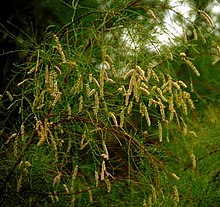Tamaricaceae
| Tamaricaceae | |
|---|---|

| |
| Tamarix in flower | |
| Scientific classification | |
| Kingdom: | Plantae |
| Clade: | Tracheophytes |
| Clade: | Angiosperms |
| Clade: | Eudicots |
| Order: | Caryophyllales |
| Family: | Tamaricaceae Link (1821) nom. cons. |
| Genera | |
The Tamaricaceae, the
tamarisk family, are a family of plants native to drier areas of Europe, Asia, and Africa. It contains four genera: Tamarix (with 73 species), Reaumuria (25 species), Myricaria (13 species), and Myrtama (a single species).[1]
In the 1980s, the family was classified in the Violales under the Cronquist system; more modern classifications (Angiosperm Phylogeny Group) place them in the Caryophyllales.
Many of the plants in the family grow on
saline soils
, tolerating up to 15,000 ppm soluble salt and can also tolerate alkaline conditions. The leaves are generally scale-like, measure 1–5 mm long, overlap each other along the stem, and in some species are encrusted with salt secretions.
References
- ^ "Tamaricaceae Link". Plants of the World Online. Royal Botanic Gardens, Kew. Retrieved 7 November 2022.
